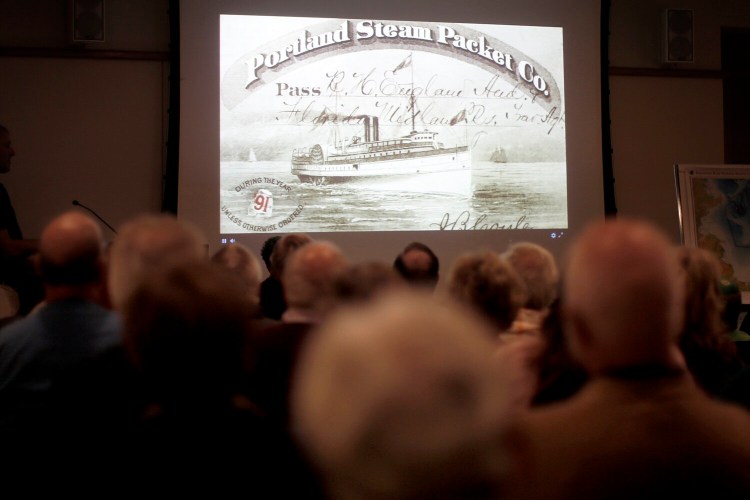When the SS Portland set sail from Boston on Nov. 27, 1898, businessman James H. Tupper was on his way home to Bath. Merchant George H. Cole was returning to Portland after buying flour to sell in Maine. And second steward Frances Eben Heuston, who had recently bought a house on Munjoy Hill, was working aboard the luxurious steamship.

Mourning pins contain photos of three people who died when the SS Portland sank in 1898. Gillian Graham/Staff Writer
Within hours, waves from a massive gale overcame the 291-foot ship, sinking it off the coast of Massachusetts and killing all of the nearly 200 people on board. It was days before anyone knew the ship was lost and nearly a century before the wreck was discovered.
On Wednesday, descendants of Tupper, Heuston and Cole were among more than 60 people who gathered at the Maine Historical Society in Portland to watch as researchers remotely explored the shipwreck for the first time in a decade.
“Sometimes I can’t imagine what it must have been like,” said Fran Silcock, 84, the granddaughter of Cole, a flour merchant from South Portland. “I often wonder were they in bed asleep? Did they know what was happening?”
The story of the Portland is well-known in Maine, even though not much is known about why Capt. Hollis Blanchard decided to head out when a large storm was expected or what he did once 40-foot waves started pummeling the boat.
But researchers are now trying to answer some of those questions – and study the marine life flourishing on and around ship’s remains – by using remotely operated vehicles to get a better look at the wreckage, which sits upright in the waters of the Stellwagen Bank National Marine Sanctuary.
The Woods Hole Oceanographic Institution is working with the National Oceanic and Atmospheric Administration’s Office of Marine Sanctuaries and Marine Imaging Technologies to explore the wreck of the SS Portland as part of a three-year project that will include explorations of other nearby shipwrecks.
“Each wreck has its own special place as a window through time,” marine archaeologist Calvin Mires, who was aboard the research vessel working on the project, told the group at the Maine Historical Society.

Fran Silcock, 84, of Cape Elizabeth, whose grandfather George Cole died in the sinking of the SS Portland, watches a live-streamed Q&A with researchers who are exploring the shipwreck off the coast of Massachusetts. Ben McCanna/Staff Photographer Buy this Photo

Ken Thompson of Portland has collected artifacts related to the SS Portland, including a telegram sent to the family of a passenger and a newspaper clipping in which his great-grandfather recounted seeing the ship before it sank. Gillian Graham/Staff Writer
Video footage from the expedition showed the remains of the shipwreck covered with orange and white sponges, sea stars and other marine creatures. Fishing nets have snagged on the wreckage, but some of the artifacts visible to researchers include plates and cups.
Herb Adams, a Portland historian who has researched and written about the SS Portland, said seeing images of the shipwreck is powerful.
“To see the pictures is intimate, and it’s haunting that even after 125 years the memories will have such power,” he said. “It’s a living tragedy with scores of people to whom this is a tearful family memory even still.”
Bob Greene, whose grandmother was married to Heuston, the second steward, grew up in the house Heuston had bought barely a year before his death. Greene said he’s interested in the research being done and wonders if the exploration will reveal any human remains.
After the ship sank, only 51 bodies were recovered when they washed ashore on Cape Cod. At Evergreen Cemetery in Portland, there are eight graves of people who died when the ship sank, but not all of them contain remains.
For Beverly Collins of Portland, the expedition is an opportunity to learn more about the shipwreck that killed her great-grandfather, Tupper, a well-known businessman who had three children and a wife waiting for him at home.

Beverly Collins, 80, of Portland, whose great-grandfather James Tupper was among the passengers who died in the sinking of the SS Portland, watches Wednesday’s Q&A with researchers who are exploring the shipwreck off the coast of Massachusetts. Ben McCanna/Staff Photographer Buy this Photo
“It makes me feel good that people who lost their lives are still being recognized today even though they never made it home,” said Collins, who attended the event with her cousin Lynda Kinley.
Ken Thompson, a historian from Portland, brought to the historical society his collection of artifacts related to the Portland, including a telegram sent to a man that read simply, “Your mother was lost on steamer.” Thompson’s great-grandfather Capt. William D. Scott passed the steamship hours before it sank.
As Thompson showed mourning pins, commemorative plates and newspaper clippings, he reflected on the storm.
“It was unexpected, the intensity of it,” he said. “It overwhelmed everybody.”
Silcock, of Cape Elizabeth, grew up hearing stories of her grandfather, who died when his wife was only 27 and the youngest of his three children was 2. She was always fascinated by the shipwreck, but also knew the tragedy was devastating to her grandmother Eleanor, who never remarried.
For the rest of her life, Eleanor Cole would cover her ears whenever the fog horns blew.
Comments are not available on this story.
Send questions/comments to the editors.



